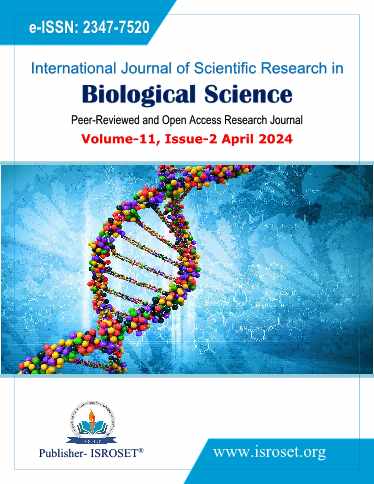Revolutionizing Mosquito Control: A Nobel Approach with Cow Dung-Based Herbal Repellents
Keywords:
Mosquito repellent, Cow dung, Herbal ingredients, Effectiveness, Comparative analysisAbstract
Mosquito-borne diseases pose significant health threats worldwide, emphasizing the urgent need for effective and affordable mosquito repellents. This study investigates the development and efficacy of a novel mosquito repellent derived from cow dung supplemented with herbal ingredients. The primary objective was to assess the feasibility and effectiveness of utilizing cow dung as a base for mosquito repellent formulation, comparing its efficacy with commercially available alternatives. Through a series of experiments and comparative analyses, it was determined that the cow dung-based mosquito repellent exhibited a remarkable effectiveness, surpassing commercial repellents by 20%. The formulation process was meticulously examined, detailing the incorporation of herbal ingredients to enhance repellent properties. Moreover, the study sheds light on the potential health and environmental implications associated with the use of conventional mosquito repellents containing synthetic pyrethroids and DDT, emphasizing the need for safer alternatives. The herbal mosquito repellent developed in this study offers a cost-effective, eco-friendly solution with minimal health risks, thereby advocating for its adoption as a viable alternative to commercial repellents. Furthermore, this research underscores the importance of industry adoption to facilitate the widespread availability and utilization of herbal mosquito repellents, thereby mitigating health risks associated with conventional alternatives. Overall, this study contributes to the growing body of knowledge on sustainable vector control methods and highlights the potential of natural remedies in combating mosquito-borne diseases.
References
N.B.S Sarkari, S.P. Barthwal, A.K Gupta, M.M.S. Bagga, S.N. Mishra, V.K. Mishra. “A clinical appraisal of two epidemics of Japanese encephalitis in eastern Utter Pradesh”. In: Proceedings of National conference on Japanese encephalitis. pp 34–40, 1984
V. Ravi, S. Vanajakshi, A. Gowda, A. Chandramuki. “A laboratory diagnosis of Japanese encephalitis using monoclonal antibodies and correlation of findings with the outcome”. J. Med. Virol. 29: 221–223, 1989
A.V. Kondrachine. “Malaria in WHO Southeast Asia region”. Indian. J. Mal. Res. 29: 129–160, 1992
M. Bhatnagar, K.K. Kapur, S. Alers, S.K. Sharma. “Laboratory evaluation of insecticidal properties of Ocimum basilicum L. and O. sanctum L. plants essential oils and their major constituents against vector mosquito species”. Ent. Res. 17: 21–26, 1993
Seyoum, G.F. Killeen, E.W. Kabiru, B.G.J. Knols, A. Hassanali. “Field efficacy of thermally expelled or live potted repellent plants against African malaria vectors in western Kenya”. Trop. Med. Int. Health. 8: 1005–1011, 2003
W.S. Choi, B.S. Park, S.K. Ku, S.E. Lee. “Repellent activities of essential oils and monoterpenes against Culex pipiens fallens”. J. Am. Mosq. Control. Assoc. 18: 348–351, 2002
J. Zhu, X. Zeng, L.T. Yanma, K. Qian, Y. Han, S. Xue, B. Tucker, G. Schultz, J. Coats, W. Rowley, A. Zhang,. “Adult repellency and larvicidal activity of five plant essential oil against mosquitoes”. J. Am. Mosq. Control. Assoc. 22: 512–522, 2006
B.K. Tyagi, T. Ramnath, A.K. Shahi. “Evaluation of repellency effect of Tagetus minuta (Family: Compositae) against the vector mosquitoes Anopheles stephensi Liston, Culex quinquefasciatus Say and Aedes aegypti L. Int. Pest. Contr”. International Journal of Biological Sciences & Research. pp 39-48, 2005
D.S. Hebbalkar, R.N. Sharma, V.S. Joshi, V.S. Bhat. “Mosquito repellent activity of oils from Vitex negundo Linn. Leaves”. Indian. J. Med. Res. 95: 200–203, 1992
Z. Li, J. Yang, X. Zhuang, Z. Zhang. “Studies on the repellent quwenling”. Malaria. Res. (In Chinese): 6, 1974
C.F. Curtis, J.D. Lines, L. Baolin, A. “Renz. Natural and synthetic repellents”. In Appropriate Technology in Vector Control, Curtis CF (ed.), ch.4.CRC Press: Florida, 1989
M.A. Ansari, R.K. Razdan. “Repellent action of Cymbopogon martini martini Stapf var. Sofia against mosquitoes”. Indian. J. Malariol. 31: 95–102, 1994
A.A. Craveiros, F.J.A. Matos, M.I.L.Machado, J.L. Alencar. “Essential oils of Tagetes minuta from Brasil. Perf. Flav”. 13: 35– 36, 1988
Gil, C.M. Ghersa, S. Leicach. “Essential oils yield and composition of Tagetes minuta accessions from Argentina. Biochem”. Syst. Ecol. 28: 261–274, 2000
E. Hethelyi, B. Danos, P. Tetenyi, G. Juhasz. “Phytochemical studies on Tagetes species; infra specific differences of the essential oil in T. minuta and T. tenuifolia”. Herb. Hungarica. 26: 145–158, 1987
Downloads
Published
How to Cite
Issue
Section
License

This work is licensed under a Creative Commons Attribution 4.0 International License.
Authors contributing to this journal agree to publish their articles under the Creative Commons Attribution 4.0 International License, allowing third parties to share their work (copy, distribute, transmit) and to adapt it, under the condition that the authors are given credit and that in the event of reuse or distribution, the terms of this license are made clear.







